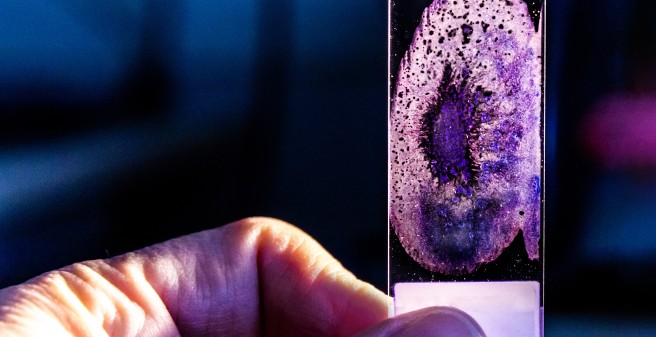Die Forschung am Institut für Klinische Chemie wird in diversen Projekten durch die Europäische Union (European Comission und European Research Council, ERC) und durch Sonderforschungsbereiche (SFB) der Deutschen Forschungsgemeinschaft (DFG) gefördert.
EU Innovative Training Networks
Analytics for Biologics (A4B)
Horizon 2020 Marie Sklodowska-Curie Action ITN 2017 of the European Commission (H2020-MSCA-ITN-2017), Prof. Dr. Hartmut Schlüter
The Analytics for Biologics (A4B) project is a Europe-wide innovative training network (ITN). Funded by the Horizon 2020 Marie Sklodowska-Curie Action ITN 2017 of the European Commission (H2020-MSCA-ITN-2017), the graduate school A4B will offer a specific training program for the production, purification, and analysis therapeutic protein species.
The A4B project is composed of 11 consortium members and 6 industrial partners.
ERC Starting Grant
Factor XII and the contact system: cross-talk between thrombosis and inflammation
ERC StG-2012-311575 "F12" Prof. Thomas Renné
Das Zusammenspiel von Entzündung und Blutgerinnung ist für eine Reihe an Krankheitsbildern des Herz-Kreislauf-Systems, wie der koronaren Herzkrankheit und dem hereditären Angioödem, mitverantwortlich. Eine Schlüsselrolle spielt dabei das Protein Faktor XII (FXII) des Gerinnungssystems. Durch unsere Forschung im Rahmen des F12-Projekts möchten wir verstehen, welche Prinzipien und molekularen Interaktionen dem Zusammenspiel von Entzündung und Blutgerinnung zu Grunde liegen und neue Therapieansätze finden.
Das F12-Projekt wird als ERC Starting Grant durch den Europäische Forschungsrat (European Research Council, ERC) gefördert.
Sonderforschungsbereich 841
Das Kontaktphasesystem bei Leberentzündungen – Schnittstelle zwischen Inflammation, angeborener Immunantwort und Gerinnung
Teilprojekt B8 – Prof. Thomas Renné
Entzündung und Blutgerinnung sind eng miteinander verknüpft und haben zentrale Bedeutung für Infektionserkrankungen. Der Faktor XII wird von Hepatozyten ins Plasma sekretiert und startet das proinflammatorische und prokoagulante Kontaktphasesystem. Die Biochemie des Kontaktphasesystems ist gut etabliert. Die in-vivo-Funktionen der Proteasenkaskade sind aber bislang nur wenig verstanden. Die Blockade des Kontaktphasesystems bietet neue Therapiestrategien, um Entzündungsmechanismen und Infektionen effizient und nebenwirkungsarm zu blockieren.
Im Rahmen des Projektes werden die Funktionen des Kontaktphasesystems und seines Aktivators Polyphosphat für Leberentzündungen und Leberinfektionen mit Mausmodellen und Patientenmaterial analysiert und hierauf aufbauend versuchen wir Therapiestrategien für Leberentzündungen zu entwickeln.
Dieses Projekt ist Teil des SFB 841 – Leberentzündung: Infektion, Immunregulation und Konsequenzen .
The function of extra cellular DNA in liver regeneration and cancer
Teilprojekt C9 – Dr. Tobias Fuchs
Inflammation plays a crucial role in tissue regeneration and in the development of cancer. Neutrophils are the dominating cell type during acute inflammation. Neutrophils are capable of releasing their DNA from the nucleus into the extracellular environment to form extracellular webs known as Neutrophil Extracellular Traps (NETs).
In order to release its DNA, the nucleus of neutrophils undergoes certain morphological changes which are summarized in the process of NETosis. Once liberated into the extracellular environment, DNA forms a fibrous network, which resembles the appearance of a spider web. NETs can interact with other cells and proteins and the goal of this project is to understand their role in liver regeneration and cancer.
Dieses Projekt ist Teil des SFB 841 – Leberentzündung: Infektion, Immunregulation und Konsequenzen .
Sonderforschungsbereich 877
Mechanismus des Faktor XII-assoziierten hereditären Angioödem (HAE) Type III
Teilprojekt A11 – Prof. Thomas Renné
Das hereditäre Angioödem (HAE) ist eine seltene erbliche Schwellungserkrankung. In Vorarbeiten konnten wir zeigen, dass HAE Typ III mit einer Punktmutation des Plasmaproteins Faktor XII assoziiert ist. Im Rahmen des SFB-Teilprojekts möchten wir Mechanismus sowie mögliche Therapien und Diagnostiken von HAE Typ III mittels rekombinanter Proteine, Ödemmodellen an genetisch modifizierten Mauslinien und Patientenplasmen untersuchen.
Dieses Projekt ist Teil des SFB 877: Proteolyse als regulatorisches Ereignis in der Pathophysiologie .
ERC Advanced Grant
SUREPIRL
Prof. Hartmut Schlüter
The SUREPIRL project (ERC Advanced Grant of Prof. Dr. Dwayne Miller, Max Planck Institute for the Structure and Dynamics of Matter, Hamburg) is based on a recent breakthrough in directly observing atomic motions during structural changes and in studying energy redistribution channels in liquid water on the femtosecond time scale.
These studies provided the key insights that drove the development of a new laser concept for direct-drive laser ablation. By judicious choice of laser pulse parameters, it is now possible to selectively excite water molecules to act as a propellant to drive molecules into the gas phase faster than any other energy exchange mechanism or growth of nucleation sites to cause shock wave damage or other deleterious effects.
With the resulting Picosecond Infrared Laser (PIRL) surgical tool, proof-of-principle studies have shown that it is possible to produce wound sizes at the fundamental limit of a single cell - with virtually no scar tissue formation. Equally important, the laser ablated molecules remain completely intact for determination of the tissue type. This is the first time it has been possible to drive intact proteins into the gas phase, in a matrix independent manner, for ultrasensitive detection using mass spectrometry.
The project represents a well coordinated effort involving medical researchers across a broad spectrum of disciplines to fully explore the applications of this new technology, from minimally invasive surgery with molecular signatures for feedback and on the fly guidance to prevent cutting critical structures, to in situ pathology and cancerous tissue identification, to detection of disease at the earliest possible stage from a single drop of body fluids. (Author: Prof. Dr. Dwayne Miller)

